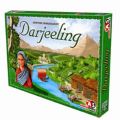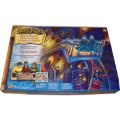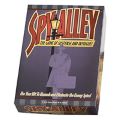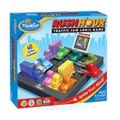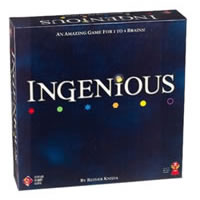
Official Ingenious Rules
How To Play Ingenious
1 - 4
Players
10+
Ages
45 MIN
Play Time
$30
Price
In Ingenious, players take turns placing colored domino-style tiles on a game board to create lines of colored symbols and score points. The ingenious aspect is that instead of scoring points based on one's best color, as would be expected, a player's score is determined by the worst-scoring of their colors. Players cannot focus on one or two colors to win the game but have to balance their scores across all colors.
The game contains 120 tiles, each of two connected hexes; each hex features one of six colors. Each player begins the game with six tiles on his rack, and on his turn, he places one tile onto the board. For every hex on that tile, the players score for all adjacent hexes in the same color and for all hexes in a straight line. If the score in any color reaches 18 at any time, the player immediately takes another turn. At the end of each turn, players refill their racks, but if they have no tiles matching their lowest-scoring color, they can discard their tiles and draw six new ones.
The game is over when nobody can set any more tiles, or when any one player reaches a score of 18 in each color. The players then look at their lowest scores, and whoever has the "high" low goes. Ingenious also includes variations for solitaire and team play-two teams of two players, each keeping a combined score which tops out at 36 instead of 18.
The game contains 120 tiles, each of two connected hexes; each hex features one of six colors. Each player begins the game with six tiles on his rack, and on his turn, he places one tile onto the board. For every hex on that tile, the players score for all adjacent hexes in the same color and for all hexes in a straight line. If the score in any color reaches 18 at any time, the player immediately takes another turn. At the end of each turn, players refill their racks, but if they have no tiles matching their lowest-scoring color, they can discard their tiles and draw six new ones.
The game is over when nobody can set any more tiles, or when any one player reaches a score of 18 in each color. The players then look at their lowest scores, and whoever has the "high" low goes. Ingenious also includes variations for solitaire and team play-two teams of two players, each keeping a combined score which tops out at 36 instead of 18.
- 120 Tiles
- 1 Bag
- The Game Board
- Four Score Boards
- Four Racks
- 24 Color Pegs
- The Ingenious Game Rules And Instructions

The player with the best score wins which is determined by the color in the player's score.

Perparation: Place the board in the middle, put the tiles inside the bag and mix them well. Each player takes a score board and places it in front of him- or herself. Place one peg of each color in the hole to the right of the corresponding color symbols (starting at 0).
Next each player has a rack in front (behind his score board). He draws 6 tiles from the bag and arranges them on the rack so that he is the only one who can see the tiles.
Game Play: For 2 players, use only the white spaces; for 3 players, include the light grey spaces; and for 4 players, use the whole board.
Each player starts with six tiles displaying color symbols on their rack. In clockwise order, players place one tile from their rack onto the board, aiming to create lines of matching symbols that will help advance their color markers on the score board. The objective is to advance all six color markers and avoid leaving any behind. When the board is filled, the player with the highest lowest-scoring marker wins the game.
On each turn, the players pick a tile from their rack and place it on any two connected empty spaces on the board. During the first round, a player has to place his tiles next to one of the six symbols already printed on the board. After placing the tile, they score for each symbol on the tile by counting matching symbols along five possible lines and advancing their respective color marker accordingly. If a player's rack doesn't include tiles with their lowest-scoring colors, they may discard their tiles, draw six new ones from the bag, and return the old tiles to the bag. If a player's marker reaches the final space - an 18 value -, he or she instantly gets a bonus play, laying another tile on the board and scoring it. The game ends when no more tiles may be laid down; whoever has the highest low-scoring marker in the colors wins. In case of a tie, the next lowest color breaks the tie. If one player lands on all six colored final spaces first, that player wins immediately.
4-Player Partnership Game: Players who sit opposite each other are partners. Each partnership uses one double-length score board and writes their individual scores on this one board. No conversation is allowed during play unless the players agree to open communication. When one counter reaches the last space on either score board it moves to the first space on the other board and player immediately gets a bonus play for the "Ingenious." Game ends when no more tiles can be placed. The partnership with the lowest counter loses.
Solitaire Game: Two regular score boards are used for this game. The goal of the game is to achieve the highest score once no more tiles can be placed. No bonus plays are allowed, and each player draws one tile at a time from the bag, placing them on the board and scoring them. Only the white spaces are used.
Please keep in mind that the official Ingenious PDF rules listed below could be different depending on the version you have. They should be an exact copy of what came in your original packaging. Download them to view now or print them for later use.
Next each player has a rack in front (behind his score board). He draws 6 tiles from the bag and arranges them on the rack so that he is the only one who can see the tiles.
Game Play: For 2 players, use only the white spaces; for 3 players, include the light grey spaces; and for 4 players, use the whole board.
Each player starts with six tiles displaying color symbols on their rack. In clockwise order, players place one tile from their rack onto the board, aiming to create lines of matching symbols that will help advance their color markers on the score board. The objective is to advance all six color markers and avoid leaving any behind. When the board is filled, the player with the highest lowest-scoring marker wins the game.
On each turn, the players pick a tile from their rack and place it on any two connected empty spaces on the board. During the first round, a player has to place his tiles next to one of the six symbols already printed on the board. After placing the tile, they score for each symbol on the tile by counting matching symbols along five possible lines and advancing their respective color marker accordingly. If a player's rack doesn't include tiles with their lowest-scoring colors, they may discard their tiles, draw six new ones from the bag, and return the old tiles to the bag. If a player's marker reaches the final space - an 18 value -, he or she instantly gets a bonus play, laying another tile on the board and scoring it. The game ends when no more tiles may be laid down; whoever has the highest low-scoring marker in the colors wins. In case of a tie, the next lowest color breaks the tie. If one player lands on all six colored final spaces first, that player wins immediately.
4-Player Partnership Game: Players who sit opposite each other are partners. Each partnership uses one double-length score board and writes their individual scores on this one board. No conversation is allowed during play unless the players agree to open communication. When one counter reaches the last space on either score board it moves to the first space on the other board and player immediately gets a bonus play for the "Ingenious." Game ends when no more tiles can be placed. The partnership with the lowest counter loses.
Solitaire Game: Two regular score boards are used for this game. The goal of the game is to achieve the highest score once no more tiles can be placed. No bonus plays are allowed, and each player draws one tile at a time from the bag, placing them on the board and scoring them. Only the white spaces are used.
Please keep in mind that the official Ingenious PDF rules listed below could be different depending on the version you have. They should be an exact copy of what came in your original packaging. Download them to view now or print them for later use.
Share with us your comments, funny stories, tips, advice, strategies, creative ways to play, questions about playing, problems with the directions, etc. All submissions will be reviewed within 24 hours.
Helen Carlisle says:
When you first go, does your oounter have to match the colour of the existing hexagon next to which it's to be placed, that is the ones printed on the board?
10-31-2023
When you first go, does your oounter have to match the colour of the existing hexagon next to which it's to be placed, that is the ones printed on the board?
Al says:
Quote Sarah's questions. Same doubts. Let us know! Thanks
12-30-2019
Quote Sarah's questions. Same doubts. Let us know! Thanks
Sarah says:
Same question as Steve. Is it permissible to lay a tile where neither colour of the tile laid matches the colour on an adjacent tile. Also, after the first turn, can you place a lone piece not connected to any other time as long as it fits on a connected empty space?
10-19-2019
Same question as Steve. Is it permissible to lay a tile where neither colour of the tile laid matches the colour on an adjacent tile. Also, after the first turn, can you place a lone piece not connected to any other time as long as it fits on a connected empty space?
Steve says:
Is it permissible to lay a tile where neither colour of the tile laid matches the colour on an adjacent tile
01-11-2019
Is it permissible to lay a tile where neither colour of the tile laid matches the colour on an adjacent tile
Greg says:
What happens when you play all six tiles during a play and still have a bonus play left? Do you draw six tiles or does the turn pass to the next player?
05-14-2018
What happens when you play all six tiles during a play and still have a bonus play left? Do you draw six tiles or does the turn pass to the next player?
Zang says:
I have a tile that has a recycling sign on it, what does that tile represent?
12-16-2016
I have a tile that has a recycling sign on it, what does that tile represent?
Here are some other games you might like to play at your next get together. Learning how to play new games can feel daunting at first but once you get the hang of it, it can be really fun to try out new games. You can also use our search feature at the top of the page to search for a specific criteria that might interest you. Who knows - you might just find your next favorite game.
